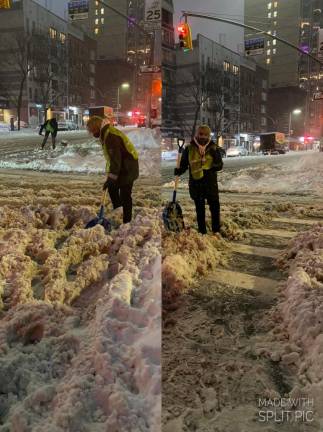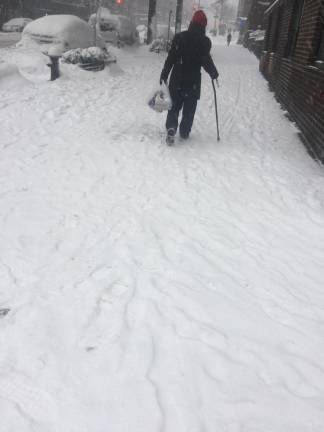Sidewalk Snow Removal is an Intersectional Issue


By Patrick Bobilin, Lindsey Cormack and Zaki Molvi
Making cities more walkable and easier to navigate should be a goal of any society.
While snow removal might seem like a needling quality of life issue that we mutter about under our breath, but about which nothing can be done, it’s more of an intersectional equity issue than we give it credit for. City sidewalks present pedestrian hazards in the best weather: scooters or bikes on sidewalks, dog waste, overturned trash bins, and now dining arrangements make use of any available space.
However, the failures of pedestrian infrastructure are displayed at their extreme when the snow starts to fall.
In the past, political careers have risen and fallen based on snow removal. Chicago mayor Jane Byrne was elected on a snow removal protest vote. New York’s Mayor Lindsay very nearly lost his re-election bid because of 1969’s February blizzard still known as “The Lindsay Snowstorm.” But concern in those cases, as has been the pattern, was focused solely on the impact for drivers.
In New York City, a minority of us are drivers, but every single one of us is a pedestrian. Despite that, not a single mayor has ever been publicly shamed for piled up snow obstructing access to schools, senior centers, or hospitals. During the February 1, 2021 blizzard, Mayor Bill de Blasio asked us to stay inside and stay off the streets. We were told to stay off the roads, and because of the pandemic, outdoor dining was shut down, leaving us to either pick up takeout or have it delivered.
Meanwhile, seniors with lower incomes and fewer resources for personal assistance had to brave the streets to meet their basic needs during an emergency. For many days after the roads were cleared, delivery bikers were forced to forgo still snowed-over bike lanes. For days, they weaved into busy traffic because major bike turnarounds, like the Queensboro Bridge “porkchop,” were left obstructed by piles of snow.
In a neighborhood like the Upper East Side, where we have a wealthier and older population with a high share of mobility issues, our curb cuts and pedestrian medians were still covered with snow still a week after the storm.
Bus Stops as Snow Forts
Representatives from the Department of Transportation at a Feburary Community Board 8 meeting were unclear as to whether it was their department or the Department of Sanitation who should be clearing the medians along the avenues. Dozens of miles of pedestrian medians were planned, poured, and installed and yet no department has standardized snow removal.
A week after the storm, bus stops remained snow forts. Bike lanes for commuters and delivery people remained hazardous. No one’s career in public office was in danger, even as pedestrians were.
During this pandemic, a trip to the hospital for a slip-and-fall could be deadly for a senior. A simple walk for milk could turn deadly because of this gap in our infrastructure.
Without universal healthcare, a trip to the hospital for a delivery rider or working-class commuter could be devastating or simply bankrupting.
A trip to the emergency room for a preventable injury due to snow could also mean one less bed open for someone who came down with COVID-19. During that transfer from one full hospital to another, a respiratory emergency could become deadly.
Filling in Need Gaps
Our goal should be to make the world safer, not less safe. With busy streets clear and pedestrians forced to walk into traffic, an untold number of injuries could be at stake as drivers go about their business as normal. And it doesn’t have to be either/or. Drivers should have cleared streets, but not at the stake of cleared pedestrian paths.
The goal of mutual aid organizations like our local UES Mutual Aid Network is to fill in infrastructure and need gaps with direct action. It is also our goal to hold the city departments that should be taking care of this as responsible partners that have let the public down .
If it’s this bad on the Upper East Side, one can only assume it’s worse in other areas where unattended potholes and cracks in the sidewalk are invisible under snow. In those areas, there are fewer traffic calming measures and even less visibility for cars to see pedestrians.
Snow removal is an intersectional equity issue and one we shouldn’t be contending with in a city aimed toward the future. Snow removal impacts people who walk to work and who rely on buses. Snow removal impacts food delivery workers. Snow removal impacts kids and people caring for kids. Snow removal impacts essential workers.
We’ve had snow long before we’ve had cities. It’s time to place removal and safety in our plans for safer and walkable streets. Vision Zero cannot exist without planning for accessible streets with a reliable and clear snow removal plan for pedestrians.
An increasing number of neighbors and mutual aid organizations are taking it upon themselves to fill the cracks in our infrastructure. While applause and “thank you”s are nice, the real changes must be built into our infrastructure. There aren’t enough mutual aid organizations in the world to compete with the scale of city departments which should anticipate these needs without the need for community action to pick up the slack.
We must be ready to make these demands, make them loudly, and remain persistent on behalf of those who may be resigned to accept these breaks in the social contract as normal. It’s not normal.
Patrick Bobilin, Lindsey Cormack and Zaki Molvi are the key organizers of UES Mutual Aid Network.